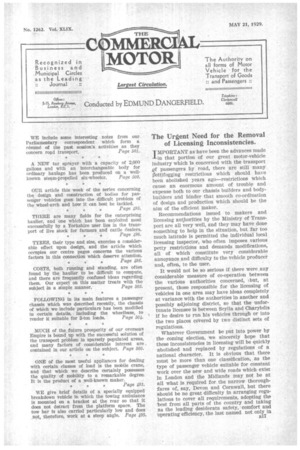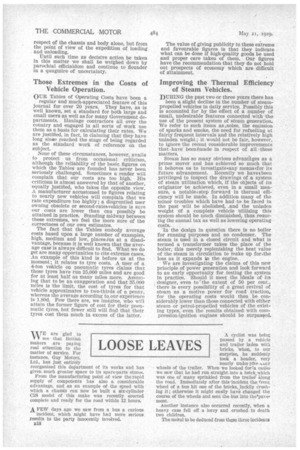The Urgent Need for the Removal of Licensing Inconsistencies.
Page 43

Page 44

If you've noticed an error in this article please click here to report it so we can fix it.
IMPORTANT as have been the advances made in that portion of our great motor-vehicle industry which is concerned with the transport .ef passengers by road, there are still many i5ettifogging restrictions which should have been abolished years ago—restrictions which cause an enormous amount of trouble and expense both to our chassis builders and bodybuilders and hinder that smooth co-ordination • of design and production which should be the aim of the efficient maker.
Recommendations issued to makers and licensing authorities by the Ministry of Transport are all very well, and they may have done something to help in the situation, but far too much latitude is permitted the individual local licensing inspector, who often imposes various petty restrictions and demands modifications, all of which constitute very considerable annoyance and difficulty to the vehicle producer and, often, to the user.
It would not be so serious if there were any considerable measure of co-operation between the various authorities concerned, ;but, at present, those responsible for the licensing of vehicles in one area may have ideas completely at variance with the authorities in another and possibly adjoining district, so that the unfortunate licensee is between Scylla and Charybdis if he desire to run his vehicles through or into the two places covered by two distinct sets of regulations.
Whatever Government be put into power by the coming election, we sincerely hope that these inconsistencies in licensing will be quickly abolished And replaced by regulations of a national character. It is obvious that there must be more than one classification, as the type of passenger vehicle suitable for constant work over the new and wide roads which exist in London and the Midlands may not be at all what is required for the narrow thoroughfares of, say, Devon and Cornwall, but there should be no great difficulty in arranging regulations to cover all requirements, adopting the -best from all parts of the country and taking as the leading desiderata safety, 'comfort and operating efficiency, the last named not only in respect of the chassis and body alone, but from the point of view of the expedition of loading and unloading. Until such time as decisive action be taken In this matter we shall• be weighed down by parochial officialdom and continue to flounder in a quagmire of uncertainty.
Those Extremes in the Costs of Vehicle Operation.
OUR Tables of Operating Costs have been a regular and much-appreciated feature of this journal for over 20 years. They have, as is well known, set a standard for both large and small users as well as for many Government departments. Haulage contractors all over the country and engaged in all sorts of work use them as a basis for calculating their rates. We are justified, in fact, in claiming that they have long since reached the stage of being regarded as the standard work of reference on the subject.
None of these circumstances, however, avails to protect us from occasional criticism, although the reliability of the basic figures on which the Tables are founded has never been seriously challenged. Sometimes a reader will complain that our costs are too high. His criticism is almost answered by that of another, equally justified, who takes the opposite view. A manufacturer accustomed to figures relating to nearly new vehicles will complain that we rate expenditure too highly ; a disgruntled user owning obsolete or second-rate;vehicles is sure our costs are lower than can possibly be attained in practice. Standing midway between these extremes, we feel the more sure of the correctness of our own estimates.
The fact that the Tables embody average costs based upon a large number of examples, high, medium and low, places his at a disadvantage, because it is well known that the average case is always difficult to find. What we do get are many opportunities to cite extreme cases. An example of this kind is before us at the moment ; it relates to tyre costs. A user of a 4-ton vehicle on pneumatic tyres claims that those tyres have run 25,000 miles and are good for at least half as many miles more. Assuming that to be an exaggeration and that 35,000 miles is the limit, the cost of tyres for that vehicle approximates to two-thirds of a penny. whereas the average according to.our experience is 1.80d. Few there are, we imagine, who will attain the former figure of cost for their pneumatic tyres, but fewer still will find that their tyres cost them much in excess of the latter. The value of giving publicity to these ex-treme and favourable figures is that they indicate what can be done if high-quality goods be used and proper care taken of them. Our figures have the recommendation that they do not hold out prospects of economy which are difficult of attainment.
Improving the Thermal Efficiency of Steam Vehicles.
DURING the past two or three years there has been a slight decline in the number of steampropelled vehicles in daily service. Possibly this is accounted for by the effect of a number of small, undesirable features connected with the use of the present system of steam generation. We refer to such items as noise. the emission of sparks and smoke, the need for refuelling at fairly frequent intervals and the relatively high unladen weight ; it would not be fair, however, to ignore the recent considerable improvements that have beenfnuade in respect of all these matters. Steam has so many obvious advaneages as a prime mover and has achieved so much that it behoves us to investigate any meansofor its future advancement. Recently we have%been privileged to inspect the drawings of a system of steam utilization which, if the objects of its originator be achieved, even in a small measure, a notable.:step forward in thermal efficiency will be made. In addition many of the minor troubles which have had to be faced in the past will be abolished, and the unladen weight of a complete vehicle utilizing this system should be much diminished, thus reducing the annual tax as well as lowering operating costs.
In the design in question there is no boiler for running purposes and no condenser. The steam is used in a closed circuit and what is termed a transformer takes the place of the boiler, this merely replenishing the heat value of the steam in circulation to make up for the loss as it expands in the engine. We are investigating the claims of this new principle of power generation and look forward to an early opportunity for testing the system In practice. Should it meet the ideals of its designer, even to the extent of 50 per cent., there is every possibility of a great revival of steam as a motive power for road traction, for the operating costs would then be considerably lower than those connected with either steam or petrol-propelled vehicles of the existing types, even the results obtained with compression-ignition engines should be surpas4ed.




















































































































